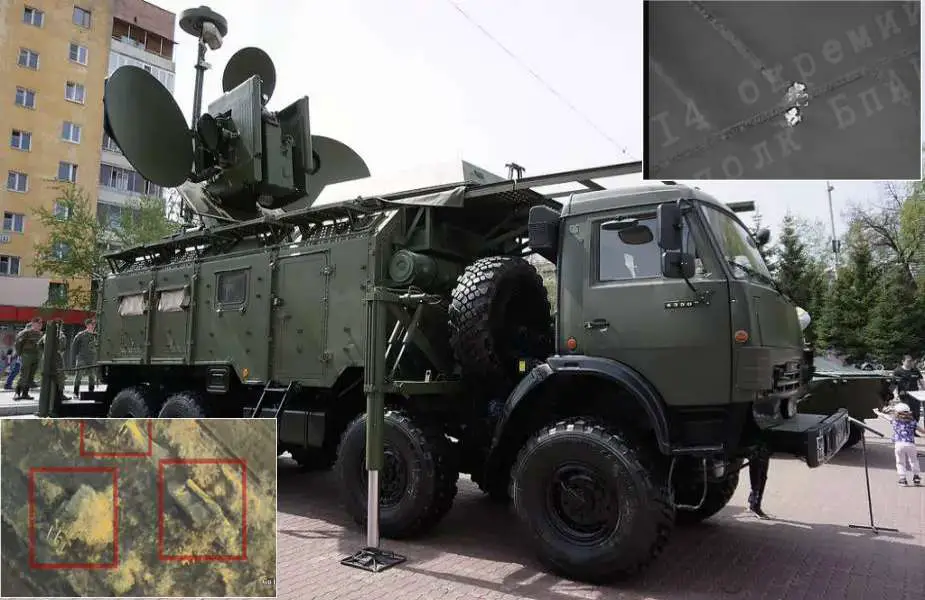- Army
- Conflicts in the world
- Israel - Iran conflict 2025
- Pakistan - India Conflict 2025
- Russia Ukraine War 2022
- Libya conflict day by day
- HAMAS - Israel War 2023
- Operation Serval in Mali French Army
- Sangaris operation Central African Republic
- Sangaris opération militaire République Centreafrique
- Ukraine - Russia conflict
- Syria conflict news
- Defence & Security Industry Technology
- Armies in the world
- Analysis Defense and Security Industry
- Conflicts in the world
- Navy
- Air
Ukrainian Forces destroy Russian Sophisticated Krasukha-4 EW System with JDAM-Guided Bomb
On November 1, 2023, a video surfaced on Ukrainian social media platforms showcasing the Ukrainian armed forces' successful neutralization of a Russian Krasukha-4 electronic warfare system, valued at $2.6 million, in the Zaporizhia region. The operation was executed using two JDAM-guided bombs. Known for its jamming capabilities against satellite and radar signals, the Krasukha-4 advanced military system was effectively destroyed by the Ukrainian army with support from the 14th Autonomous Drone Regiment's UAVs.
Follow Army Recognition on Google News at this link

Ukrainian armed forces' successful neutralization of a Russian Krasukha-4 electronic warfare system, valued at $2.6 million, in the Zaporizhia region. (Picture source: Vitaly Kuzmin)
The use of reconnaissance drones proved to be a decisive factor in the operation, enabling the Ukrainian forces to locate the concealed Russian equipment within a forested area. Despite the Russian military's attempts to camouflage their assets, the accurate intelligence gathered and the strategic execution by the Ukrainian forces culminated in the Krasukha-4's destruction.
According to open-source intelligence (OSINT) sources, this incident marks the second time Ukrainian troops have eliminated such an advanced system since the escalation of the conflict with the large-scale invasion by Russian forces in February 2022. The dismantling of the Krasukha-4 significantly undermines the electronic warfare support previously afforded to Russian troops.
The Oryx website, renowned for its detailed tracking of military equipment losses and captures in conflict zones, has verified that a Krasukha-4 system was indeed recovered in good condition after being abandoned near Kyiv. Captured intact in March 2022, the system was reportedly first moved to the US Air Force base in Ramstein, Germany, and was later transferred to the United States for further analysis.
The extent to which the NATO analysis of the captured system contributed to the destruction of this particular unit remains unknown, but such intelligence could potentially offer significant insights into countering the system's capabilities.
The Krasukha-4, a sophisticated mobile EW system, is a key component of Russian defense capabilities. Manufactured by the Bryansk Electromechanical Plant and developed under the auspices of the KRET corporation, it is engineered to disrupt radar, GPS, and communication signals across distances ranging from 150 to 300 kilometers. Its primary targets are low Earth orbit (LEO) observation satellites, terrestrial radars, and airborne radar systems, including AWACS.
Functioning through the generation of electronic interference, the Krasukha-4 system hampers the functionality of enemy radars, communications, and data transmission, effectively incapacitating opposing forces. Beyond defensive operations, it is also designed to damage the electronic warfare systems and communication networks of adversaries.
The Russian Defense Ministry incorporated the Krasukha-4 into its military assets in November 2013, with the objective of enhancing its radar jamming prowess. It has been characterized as an effective counter to "flying radars" such as the USAF E-8 Joint STARS, reconnaissance satellites like the US Lacrosse, and various surveillance and combat drones.
The loss of the Krasukha-4 system signifies a considerable impediment to Russian electronic warfare operations in Ukraine. The Ukrainian forces' capability to detect and dismantle such a pivotal asset reflects their increasing expertise in electronic warfare and reconnaissance tactics.
As hostilities persist, the role and countermeasures of electronic warfare systems like the Krasukha-4 continue to be of paramount importance. The recent developments may lead to a strategic reassessment of electronic warfare methods and the safeguarding of critical military equipment in the theater of war.


























